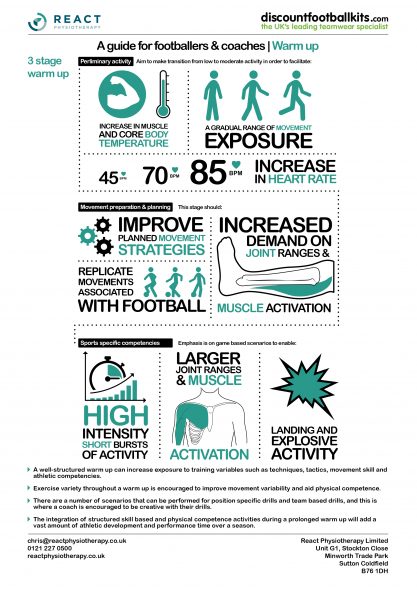Effective Warm Up – A guide for footballers & coaches
A warm up is a vital part of football preparation. At the elite level of football, the warm up protocol continues to evolve. A few minutes of stretching and touches on the ball is no longer considered sufficient preparation for training or a match.
A well-structured warm up can increase exposure to training variables such as technique, tactics, movement skill and athletic competencies.
The aim of a warm up is to prepare the players both physically and mentally for the activity ahead. A structured warm up can contribute to ongoing injury prevention (1), strength, conditioning, technical and tactical aspects of the game.
Modifications can be made to the protocol depending on the planned activity. For example, the warm up prior to a match may have a structure that is both reproducible and routine, to aid planning and preparation for the match. Whereas training session warm ups should be approached differently (discussed further below).
The following three stage warm up can be used in preparation for a match or training session and time recommendations are variable. It is essential to bear in mind that prior to a game, the routine shouldn’t expose players to fatigue. Therefore, at the later stages of the warm up when the intensity may increase, be aware of the need for rest periods between sets of activity. During a training session, the warm up can be prolonged so that more time can be dedicated to specific tactical, technical or physical elements.
Three stage warm up
Stage One: Preliminary activity
Aim to:
- Achieve a graded increase to moderate activity
- Raise muscle and body temperature
- Increase heart rate
- Increase range of movement exposure
We all know that a gentle jog across a football pitch for 10 – 15 minutes will increase body and muscle temperature and heart rate, but this may not be the best way of utilising this time. The use of low grade movements that may mimic football activity and exposure to early joint ranges of movement experienced in football would be best placed at this stage. There are a variety of exercises that can be performed that are low – moderate intensity. These will introduce the body to a gradual increase of activity and movement challenges.
Exercise variety throughout a warm up is encouraged to improve movement variability and aid physical competence.
Exercise examples:
- Heel kicks
- High knee drive
- Over the gate
- Side steps
- Carioca
- Jog
- Low skipping
Stage Two: Movement preparation and planning
During this part of the warm up the intensity should be increased slightly. This doesn’t mean that all exercises are performed quicker. It may mean that an exercise puts more demand on joint ranges or muscle activation, and the exposure to ranges of movement will be increased. This presents a bigger challenge to the person and is therefore priming the individual ready for football. Exercises performed at this stage will again tend to look like movements associated with football, or breakdown movements to isolate larger joint ranges.
It is recommended to maintain planned movement strategies during this stage, therefore the exposure to these larger, more demanding activities remains within the individual’s conscious planning.
Example exercises may include:
- Walking lunges
- Skipping
- Zig zag runs
- Leg swings
- Side shuffles
- Planned change of direction
- Landing preparation – double and single leg
- Moderate acceleration/deceleration
Stage Three: Sport specific competencies
During this final preparation stage, an emphasis is placed on trying to get as close to game-based scenarios as possible. This will enable exposure to high intensity short bursts of activity, larger joint ranges and muscle activation. Single leg landing and explosive jumping activity is recommended at this stage along with reactive scenarios to increase agility.
Example exercises are:
- Bounding/hopping/jumping (plyometric)
- Reactive change of direction
- High speed acceleration/deceleration
- Small group work (include decision making scenarios and ball work)
Group based activities and drills are ideal to introduce at this stage.
Examples of this could be:
- Working with defenders as a group, so that scenarios can be produced for them to make positional decisions off each other (mental). Defenders can decide if to go and attack the ball (mental), which may involve jumping to head the ball (physical).
- Midfield players may perform drills which include making positional and change of play decisions and the addition of acceleration work to get in position to support a pass.
- A 5 v 5 keep ball in a small area. This type of activity has all elements required at this stage. It introduces ball work, decisions about passing and moving when in possession, decisions about closing, tracking runners, short bursts of acceleration and deceleration, contact and reacting to the play.
The key with this type of activity is high intensity, therefore the time performing this before a game needs to be limited. Ensure that rest is taken between repetition of this activity.
There are a number of scenarios that can be done for position specific drills and team based drills, and this is where I would encourage a coach to be creative with their drills.
Equipment
It is not necessary to have lots of equipment for warm ups, but it is recommended to have cones, discs, hurdles, hoops and balls. Equipment not only gets the individual more engaged in the activity, but it also aids the control over the activity in terms of distance to run, angle of change of direction, range of movement exposure and jump height.
Training session
Where a training session may differ from a match day warm up is in the variation of the warm up content. It may be beneficial to keep a well-structured routine for match days as it immerses the players in the mindset that they are now beginning their final preparations for the game. This helps to mentally prepare for the game, and educate players in the importance of an effective and well-structured warm up.
Warm up for training sessions will need to prepare players for the appropriate intensity of the training session. Training session warm ups may be longer to add more technical aspects of what you are to achieve in the training session. It may also be extended to add improvements to physical components (1). Or it may have more of a movement or skill based approach to aid physical competencies, especially in the younger player (9).
The integration of structured skill based and physical competence activities during a prolonged warm up will add a vast amount of athletic development and performance time over a season.
Age-specific warm up
Young athletes are different to adult athletes and during the growth and maturation of the young athlete, a greater emphasis may be put on specific athletic qualities (9). There can be a wide variation in maturation within an age group. Some adolescents may be able to control their body at high speed and have capacity to react to changes of movement in a controlled way. Whereas others may find it difficult to control and decelerate their body.
Growth and maturation have been shown to influence potential talent identification (10) and sport performance has been shown to progressively improve with growth and maturation (3).
Have you ever performed a drill with a junior team and the drill keeps breaking down with one or two specific players? It might not be that the players are not technically able to cope with it, it may be down to their maturation and lack of athletic capacity and ability to decelerate or control their own body. Then add a ball and reactive scenario to this and the challenge will be even more demanding and potentially unachievable for some. A good use of movement preparation and planning may aid the physical literacy of the players, during periods of growth and maturation.
Using a warm up appropriately with an adolescent gives a large amount of additional time over a season to aid the athletic development of the player. If an adolescent or junior team is participating in football activity three times per week, then I would consider using different sporting activities as part of the warm up, to increase the variety of activity exposure and contribute to overall athletic development and reduced injury risk (3).
Integration into grassroots
A large proportion of research into warm up drills has been performed with elite sport in mind. The principals upon which the elite level sports base their warm up activity can also be utilised in grass roots football.
One of the main areas in which grass roots football can utilise the warm up is at training sessions. Structuring the warm up in training either as a stand-alone session or an integration into the technical and tactical aspects of the training session will give a vast amount of time over a season for specific exposure to a variety of performance and skill based activities.
Stretching
It’s hard to talk about warm ups without touching on the subject of stretching. Stretching is an exercise that can be performed statically or dynamically. Dynamic stretches or dynamic movements form a valuable part of the warm up protocol. Dynamic drills expose the joints and soft tissues to a progressive increase in range of movement and velocity changes.
There is debate regarding the significance of static stretches in warm ups. At the elite level, the use of static stretching in warm up has reduced significantly. Having said that, there is a widespread belief in the footballing community that static stretching remains an integral part of the warm up.
Having worked in the elite football environment for over ten years, it became evident that players needed to be educated on the role of stretching. The fact that their joints and soft tissue are exposed to wide ranges and changes in velocity during a match means that warm ups should be based on a wide variety of progressive dynamic movements, rather than static stretching alone.
Static stretches have been found to have negative effects on athletic performance. They can affect a variety of performance outcomes such as reduced peak muscle contraction (4), reduced agility performance (11), reduced speed (6) and have no benefit to injury prevention (7). Whereas dynamic stretches have been found to have positive effects on performance outcomes such as being effective preparation for high speed and power activity (8, 5, 6) and increased agility performance (11).
Static stretches may be useful for those players that have an association with a need to feel a static stretch. The key aspect is that the static stretches are performed early in the warm up and should be followed by dynamic activity in preparation for performance (2). The issue may be that after a well-structured, dynamic and progressive warm up, a player then goes off and performs static stretches immediately before a game which could affect their physical performance qualities in the early stages of the game.
Feel free to download/print off the infographic below to hang in dressing rooms or give out to players & coaches.
Here at Discount Football Kits, we have an wide range of training accessories available to purchase, that can help improve your teams warm up routine. Check out our accessories here!












very good very helpful. Best sport site ever.